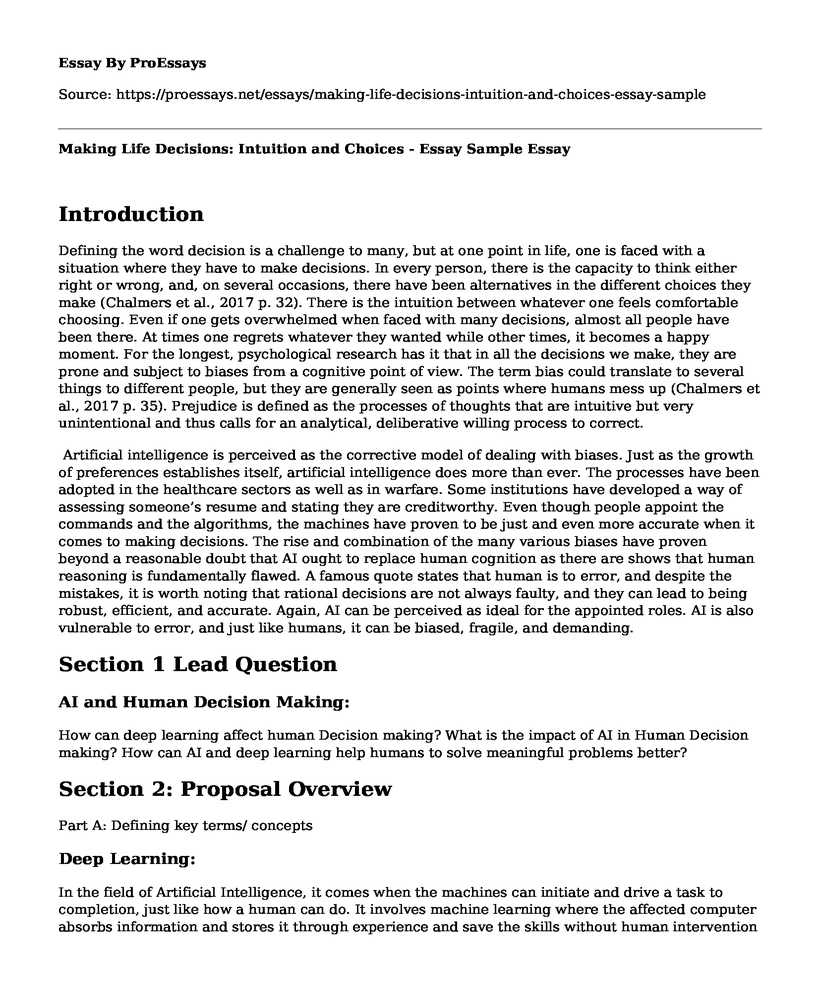Introduction
Defining the word decision is a challenge to many, but at one point in life, one is faced with a situation where they have to make decisions. In every person, there is the capacity to think either right or wrong, and, on several occasions, there have been alternatives in the different choices they make (Chalmers et al., 2017 p. 32). There is the intuition between whatever one feels comfortable choosing. Even if one gets overwhelmed when faced with many decisions, almost all people have been there. At times one regrets whatever they wanted while other times, it becomes a happy moment. For the longest, psychological research has it that in all the decisions we make, they are prone and subject to biases from a cognitive point of view. The term bias could translate to several things to different people, but they are generally seen as points where humans mess up (Chalmers et al., 2017 p. 35). Prejudice is defined as the processes of thoughts that are intuitive but very unintentional and thus calls for an analytical, deliberative willing process to correct.
Artificial intelligence is perceived as the corrective model of dealing with biases. Just as the growth of preferences establishes itself, artificial intelligence does more than ever. The processes have been adopted in the healthcare sectors as well as in warfare. Some institutions have developed a way of assessing someone’s resume and stating they are creditworthy. Even though people appoint the commands and the algorithms, the machines have proven to be just and even more accurate when it comes to making decisions. The rise and combination of the many various biases have proven beyond a reasonable doubt that AI ought to replace human cognition as there are shows that human reasoning is fundamentally flawed. A famous quote states that human is to error, and despite the mistakes, it is worth noting that rational decisions are not always faulty, and they can lead to being robust, efficient, and accurate. Again, AI can be perceived as ideal for the appointed roles. AI is also vulnerable to error, and just like humans, it can be biased, fragile, and demanding.
Section 1 Lead Question
AI and Human Decision Making:
How can deep learning affect human Decision making? What is the impact of AI in Human Decision making? How can AI and deep learning help humans to solve meaningful problems better?
Section 2: Proposal Overview
Part A: Defining key terms/ concepts
Deep Learning:
In the field of Artificial Intelligence, it comes when the machines can initiate and drive a task to completion, just like how a human can do. It involves machine learning where the affected computer absorbs information and stores it through experience and save the skills without human intervention or support (Shrestha et al., 2019 p.67). On the other hand, deep knowledge is a subset of the machine, where neural networks, as well as algorithms that are stimulated by social cognition, can understand and learn from the massive amounts of data. Just like the way people learn through experience (Shrestha et al., 2019 p.68). The algorithm on deep learning would do a task repetitively now and then changing the approach to have a better outcome in every attempt. There is a reference to deep learning because the neural networks have many but similar layers that facilitate in the learning processes. Deep learning is always in a position to solve any problem that calls for thought to understand and figure it out.
Machine learning:
Machine learning is embedded in Artificial Intelligence that ensures the systems can automatically learn and improve from the different experiences without having to be explicitly designed (Shrestha et al., 2019 p.72). Machine learning’s objective is always to have an ideal computer program development that can access data and manipulate it and even learn from it and for themselves.
References
Chalmers, C., Carter, M.L., Cooper, T. and Nason, R., 2017. Implementing “big ideas” to advance the teaching and learning of science, technology, engineering, and mathematics (STEM). International Journal of Science and Mathematics Education, 15(1), pp.25-43.
Shrestha, Y.R., Ben-Menahem, S.M. and Von Krogh, G., 2019. Organizational Decision-Making Structures in the Age of Artificial Intelligence. California Management Review, 61(4), pp.66-83.
Cite this page
Making Life Decisions: Intuition and Choices - Essay Sample. (2023, Aug 26). Retrieved from https://proessays.net/essays/making-life-decisions-intuition-and-choices-essay-sample
If you are the original author of this essay and no longer wish to have it published on the ProEssays website, please click below to request its removal:
- Leadership Concepts and Practice Essay
- Decision-Making in a Role of a Manager Paper Example
- Essay on Organizations as Complex Systems
- Trinity Community Hospital's Risk Assessment Paper Example
- Paper Example on Risk Analysis for ABC Motor Corp: Identifying & Managing Threats
- Essay on SmartTech Consultants: 5-Year Strategic Plan for Up-Scaling & Quality Service
- Essay Example on Strebel: Contingent Perspective on Corporate Governance







